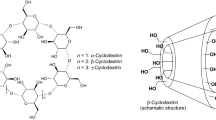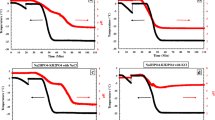Abstract
The effect of ionising radiation on the physico-chemical properties of salts of three alkaloids has been studied: codeine phosphate (COD), papaverine hydrochloride (PAP) and pilocarpine hydrochloride (PIL). These compounds in the solid state were irradiated with an e-beam of the energy of 9.96 MeV to achieve doses ranging from 25 to 400 kGy, and then they were subjected to organoleptic analysis, thermal analysis (differential scanning calorimetry, DSC), electron resonance (EPR) spectroscopy, scanning electron microscopy observations and X-ray diffraction study. The most informative were the results provided by the EPR and DSC methods. The EPR spectra revealed the presence of long-lived radicals whose concentration was directly proportional to the dose of irradiation for all the compounds studied. (PIL 2.14 × 1016 spin/g, COD 6.85 × 1015 spin/g, PAP 2.50 × 1014 spin/g—for the dose of 100 kGy). The DSC results revealed a decrease in the melting point by 5.9 °C for COD and by 0.8 °C for PIL after irradiation with 200 kGy, which is indicative of products of radiolysis, of which at least one is non-white, and changes the colour of the compounds. PAP, for which no decrease in the melting point and no colour change was observed and for which the concentration of free radicals was the lowest, was found to be most stable from among the compounds studied. It will probably be suitable for radiation sterilisation. The other two compounds COD and PIL show much lower radiochemical stability and should be subjected to more detailed examination to establish the mechanism of radiolysis and the possibility of radiation sterilisation. Our results have confirmed the earlier reports on high radiochemical stability of PAP, but do not confirm the resistance to ionising radiation of COD and PIL.








Similar content being viewed by others
References
Giron D. Thermal analysis and calorimetric methods in the characterisation of polymorphs and solvates. Thermochim Acta. 1995;248:1–59.
Bartolomei M. Solid-state studies on the hemihydrate and the anhydrous forms of flunisolide. J Pharm Biomed Anal. 2000;24:81–93.
Rustichelli C, Gamberini G, Ferioli V, Gamberini MC, Ficarra R, Tommasini S. Solid-state of polymorphic drug: carbamazepine. J Pharm Biomed Anal. 2000;23:41–54.
Karabas I, Orkoula MG, Kontoyannis CG. Analysis and stability of polymorphs in tablets: the case of risperidone. Talanta. 2007;71:382–6.
Fernandes NS, Carvalho Filho MAS, Mendes RA, Ionashiro M. Thermal decomposition of some chemiotherapic substances. J Braz Chem Soc. 1999;10:459–62.
Verma RK, Garg S. Selection of excipients for extended release formulations of glipizide through drug–excipient compatibility testing. J Pharm Biomed Anal. 2005;38:633–44.
Ceschel GC, Badiello R, Ronchi C, Maffei P. Degradation of components in drug formulations: a comparison between HPLC and DSC methods. J Pharm Biomed Anal. 2003;32:1067–72.
Mura P, Maestrelli F, Cirri M, Furlanetto S, Pinzauti S. Differential scanning calorimetry as an analytical tool in the study of drug-cyclodextrin interactions. J Therm Anal Calorim. 2003;73:635–46.
de Souza NAB, Medeiros ACD, Santos AFO, Macêdo RO. Thermal stability of metronidazole drug and tablets. J Therm Anal Calorim. 2003;72:535.
Cieśla K, Eliasso AC. Influence of gamma radiation on potato starch gelatinization studied by differential scanning calorimetry. Radiat Phys Chem. 2002;64:137–48.
Katusin-Razem B, Hamitouche K, Maltar-Strmecki N, Kos K, Pucic I, Britvic-Budicin S, et al. Radiation sterilization of ketoprofen. Radiat Phys Chem. 2005;73:111–6.
Marciniec B, Kozak M, Naskrent M, Dettlaff K, Ogrodowczyk M, Stawny M, et al. Thermal study of four irradiated imidazoline derivatives in solid state. J Therm Anal Calorim. 2007;88:337–42.
Marciniec B, Kozak M, Ogrodowczyk M. Thermal analysis in evaluation of the radiostability of some 1, 4-dihydropyridine derivatives. J Therm Anal Calorim. 2004;77:581–96.
Marciniec B, Stawny M, Kozak M, Naskrent N. The influence of radiation sterilization on thiamphenicol. Spectrochim Acta A. 2008;6:865–70.
Basly JP, Basly I, Bernard M. ESR spectroscopy applied to the study of pharmaceuticals radiosterilization: cefoperazone. J Pharm Biomed Anal. 1998;17:871–5.
Basly JP, Longy I, Bernard M. Radiation sterilization of formoterol. Pharm Res. 1997;14:810–4.
Colak S, Korkmaz M. Investigation of radiosterilization and dosimetric features of sulfacetamide sodium. J Pharm Biomed Anal. 2004;19:791–8.
Schulte KE, Henke G. Einwirkung von Gamma- und Neutronen-Strahlung auf Arzneistoffe [Effect of gamma and neutron radiation on drugs]. Arch Pharm. 1973;306:182–97.
Boess C, Bögl KW. Influence of radiation treatment on pharmaceuticals—a review: alkaloids, morphine derivatives, and antibiotics. Drug Dev Ind Pharm. 1996;22:495–529.
Pharmacopeia Polonica VI. Warszawa: PTFarm; 2002.
European Pharmacopoeia, 5th ed. Strasbourg: Council of Europe; 2005.
Pharma Cosmetics. Material Safety Data Sheet of Codeine Phosphate Hemihydrate http://www.pharma-cosmetic.com.pl/PDF/Codeini_phosphas.pdf. Accessed 15 Jan 2007.
EN 552. Sterilization of medical devices—validation and routine control of sterilization by irradiation. European Committee for Standardization, Rue de Strassart 36, B-1050, Belgium. CEN; 1994.
Varshney L, Dodke PB. Radiation effect studies on anticancer drugs, cyclophosphamide and doxorubicin for radiation sterilization. Radiat Phys Chem. 2004;71:1103–11.
Crucq AS, Deridder V, Tilquin B. Radiostability of pharmaceuticals under different irradiation conditions. Radiat Phys Chem. 2005;72:355–61.
Yang L, Yin H, Zhu W, Niu S. Determination of codeine phosphate and codeine in thermal characterization by differential scanning calorimetry. J Thermal Anal. 1995;45:207–10.
Acknowledgements
The authors gratefully acknowledge and thank Dr. Ewa Jaroszkiewicz for her contributions and assistance in manuscript editing.
Author information
Authors and Affiliations
Corresponding author
Rights and permissions
About this article
Cite this article
Marciniec, B., Kozak, M., Naskrent, M. et al. DSC and EPR analysis of some radiation sterilized alkaloids. J Therm Anal Calorim 102, 261–267 (2010). https://doi.org/10.1007/s10973-009-0445-1
Received:
Accepted:
Published:
Issue Date:
DOI: https://doi.org/10.1007/s10973-009-0445-1




